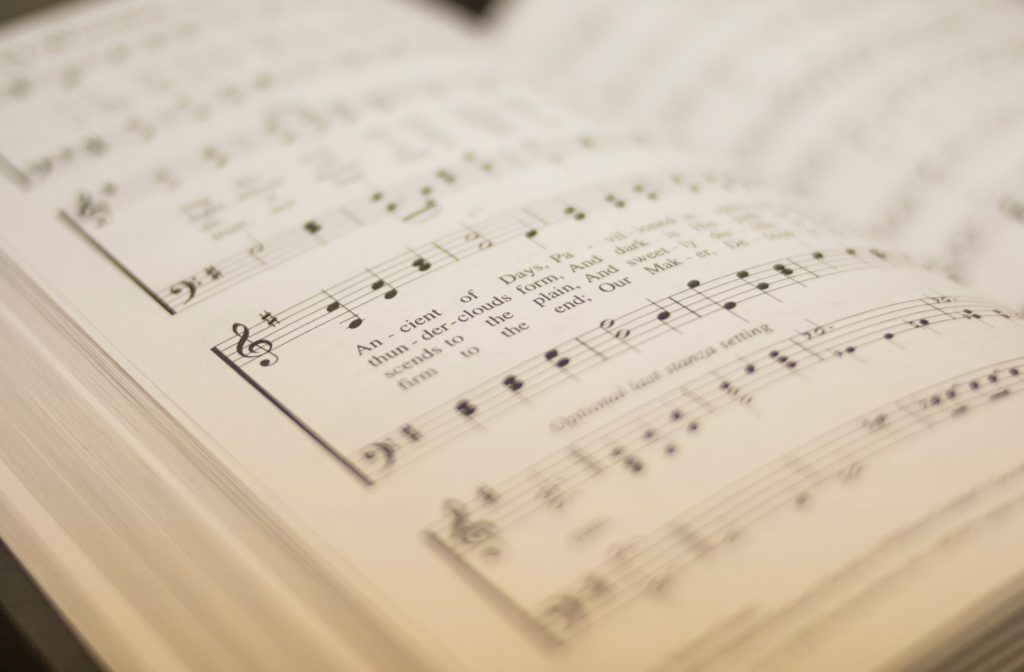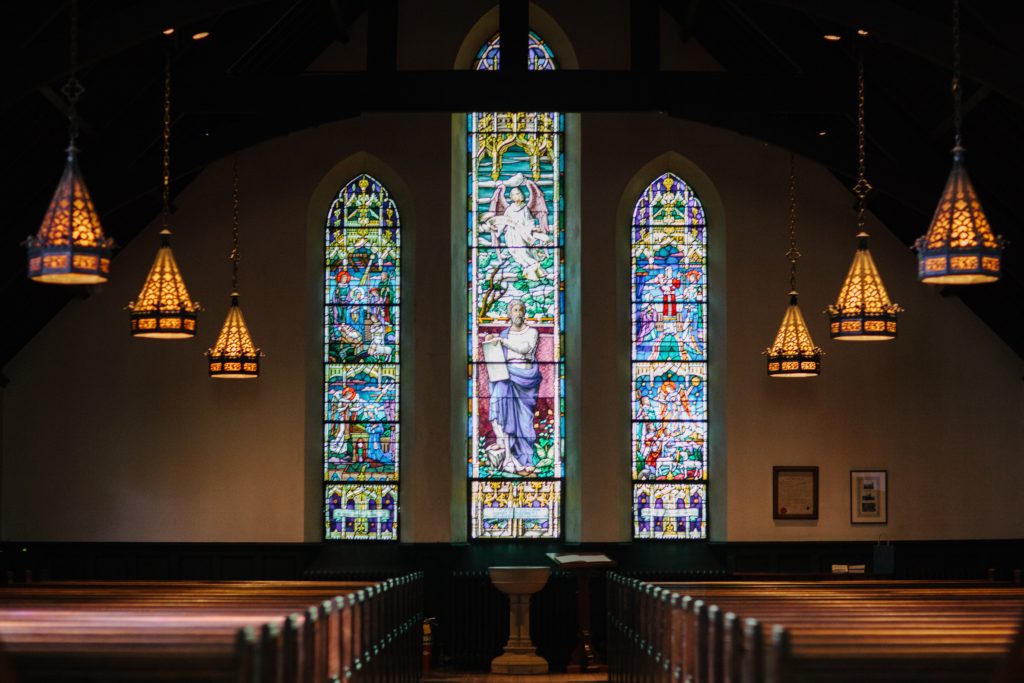
In the course of many conversations with other church musicians, I’ve heard about a variety of challenges with congregational singing. Because there are so many factors at play, each situation presents its own unique combination of problems. For that reason, I will tackle each problem one at a time in a series of articles devoted to church hymnody. This article addresses how to keep familiar old hymns as fresh and vibrant as possible. I can tell you from personal experience that it is worth the effort to improve your congregational hymn singing.
Contents
Think about the placement of stronger singers.
Be the master of your acoustic.
Walking the fine line of tempo choice
Experiment with simple improvisation formulas.
The scalar fill-in method for introductions
Think about the placement of stronger singers.
If you have a choir, then by default you have a group of more confident singers who can aide the weaker voices. The trouble is that liturgical traditions (and church acoustics) prevent us from making the best use of these stronger voices. Packing the choir into a chancel or loft makes sense for choral anthems, but it doesn’t help very much with congregational singing. This isn’t such a big deal when the pews are full. Safety in numbers means that folks are more likely to lift their voices in song. (In my view, singing isn’t something people should feel shy about in the first place, but that’s a different issue.)
If your church is at all typical, it was built for a larger group of people than it currently houses. For that reason alone, we would all do well to consider where we place our stronger singers during the hymns. I emphasize three benefits to placing strong singers out in the pews, where they can breathe new life into old hymns:
- It builds confidence in weaker singers, who sometimes feel exposed in isolation.
- It makes communal singing more fun by creating “surround sound” in real time.
- It compensates for lifeless acoustics by providing a sensation of echo.
Ready to give it a try? Scatter those choir members far and wide and tell them to make a joyful noise.
Be the master of your acoustic.
If you are the organist, pianist, or other instrumentalist responsible for accompanying the familiar old hymns, this is for you. Here’s a quick guide to help you make the best possible use of your sanctuary or other worship space. Old hymns sound even older and staler when you don’t respect the acoustic. We all have to start with what the room gives us—which sometimes isn’t very much.
Legato touch is the default.
One of the simplest ways to create the sensation of reverberation is to smoothly connect each note to the next. At the very least, you should ensure that your pedaling and fingering choices enable you to play a legato bass. In the deadest of dead rooms, you might even enter the land of “over-legato.” This means that you deliberately “blur” one note into the next to compensate for the poor acoustic. It can be a surprisingly hard thing to achieve, especially on electro-pneumatic organ keyboards with a low contact point. (This means that the note doesn’t “fire” until the key is very close to the keybed.)
What if you’re lucky enough to have a great acoustic to begin with? You should still play legato, but you’ll have more leeway at the ends of phrases and between stanzas. Take plenty of time to breathe with the singers.
Bad acoustics or not, I suggest filling in some of the spaces between phrases. Have one voice continue while the others break. This might mean adding passing tones in the bass or alto, or improvising some decorative passagework.
Walking the fine line of tempo choice
The question of tempo is especially important in old hymns; they don’t enjoy the sense of freshness that comes from merely being new.
First things first: you won’t please everyone all the time. (Have I said this before?) You need to balance two main concerns. One is to choose a tempo that allows the congregant to sing comfortably while still understanding the words. The other is to choose a tempo that sounds “upbeat” enough to encourage people to join in. These two concerns often work against each other, which is why tempo choice is such a difficult topic.
In principle, how the hymn sounds to an observer shouldn’t matter. Hymnody is music for participation; how it sounds is not really the point. However, many congregants will take issue with “funeral dirge” tempos and may tire of participating when this is what they perceive.
In responsive, reverberant spaces you can get away with slower tempos because the space itself adds life to the sound. Thus, you can slow the tempo for comprehensibility without fearing the dirge effect. In less responsive, drier spaces your range of acceptable tempos will be much smaller. Try to pick tempos at the upper end of this range, and be sure to play as legato as possible.
A word on organ registration
I won’t go into a lot of detail here, because many of my readers aren’t organists. But those who are will appreciate a little guidance.
As if touch and tempo weren’t already subjective enough, registration is a minefield. One person’s brilliant and lively is another person’s shrill and offensive. Likewise, what one listener perceives as a full, round, and supportive registration might sound dark and drab to another.
With this caution in mind, here are a few registration ideas to freshen the sound of old hymns.
- Most church organs in North America feature a rather plain-sounding principal chorus. Quiet reeds and strings add color to the sound without squeakiness. You can enclose these “color” stops if they dominate the chorus too much.
- Learn to play hymns with the melody “soloed out” in the tenor register. You might be surprised to find how many stops you can draw together for a colorful solo sound. Fill in the harmonies with a basic principal, string, and flute chorus.
- If your organ was built between 1940 and 1970, your mixtures are probably way too high and way too loud. Use them sparingly.
For more detail on these points, check out the sample chapter of my e-book on hymn playing.
Experiment with simple improvisation formulas.
Improvisation is intimidating, and for good reason. We are taught that experts know all the answers, yet learning to improvise involves making a lot of mistakes when people are watching. We struggle to resolve the tension between those two ideas. However, when you’re playing old hymns in church, it pays to have a bag of tools for basic improvisation. A little creative risk-taking goes a long way; it’s often “one step backward, two steps forward.”
With that in mind, I’m going to give you two simple formulas to put into practice right away. One of them makes your introductions more compelling so that people will want to join in. The other adds a little flavor to your accompaniment while the congregation sings.
The scalar fill-in method for introductions
Place your left foot on scale degree one in the lowest octave of the pedal. Place your left hand in the tenor range of an accompanying manual and begin playing the notes of the scale that correspond to the key of the hymn. Once you’ve got the left hand spinning along, add the right hand, which will play the melody of the hymn.
If the melody adds accidentals at some point, simply modify those same notes in your accompaniment. Move your left foot, one diatonic step at a time, as you see fit. Pretty soon, you’ll have made it to the end of your improvised introduction!
The alto descant formula
This is one of the simplest techniques in the book, doubly useful for familiar old hymns. Add a little variety to your verse accompaniments with this simple trick.
In one of your verses (usually the final one), place the alto part highest in the texture. This positions it above all the other parts, creating a descant that soars over the congregation. Fill in the harmony in as many parts as you wish. Eight parts, even ten parts, is OK!
Old Hymns Made New
These purposeful experiments are designed to develop your sensitivity to the many factors that influence your hymn playing. Remember that each of these ideas is a launching pad for your practice, not a prescription to be followed rigidly. Each Sunday affords you a new opportunity to breathe new life into old hymns. With careful preparation and a little creative risk-taking, you too can learn to make old hymns new again.
*********
Ready to revitalize your congregational singing? For more details, check out the sample chapter of my new e-book on hymn playing, and if you haven’t already, sign up for my e-mail list. You’ll be the first to hear about new resources for better church music.


What do you think? Leave a reply.